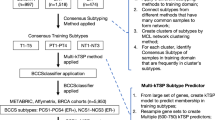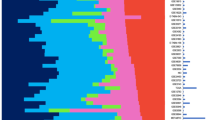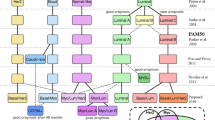Abstract
It has been proposed that gene expression profiles will revolutionize the classification of breast cancer, eventually replacing histopathology with a more reproducible technology. These new approaches, combined with a better understanding of the cellular origins of breast cancer, should enable us to identify patient subgroups for more effective therapy. However, in such a rapidly advancing field it is essential that initial and thought-provoking results do not become established as 'facts' without question. This Opinion addresses some of the negatives and positives generated by the term 'basal-like' breast cancer, and questions its existence as an entity.
This is a preview of subscription content, access via your institution
Access options
Subscribe to this journal
Receive 12 print issues and online access
$209.00 per year
only $17.42 per issue
Buy this article
- Purchase on Springer Link
- Instant access to full article PDF
Prices may be subject to local taxes which are calculated during checkout




Similar content being viewed by others
References
Blamey, R. W. et al. Survival of invasive breast cancer according to the Nottingham Prognostic Index in cases diagnosed in 1990–1999 Eur. J. Cancer 43, 1548–1555 (2007).
National Institutes of Health Consensus Development Conference statement: adjuvant therapy for breast cancer, November 1–3, 2000. J. Natl Cancer Inst. Monogr. 93, 5–15 (2001).
Goldhirsh, A. et al. Meeting highlights: updated international expert consensus on the primary therapy of early breast cancer. J. Clin. Oncol. 21, 3357–3365 (2003).
Reis-Filho, J. S. & Tutt, A. N. Triple negative tumours: a critical review. Histopathology 52, 108–118 (2008).
Reis-Filho, J. S. & Lakhani, S. R. Breast cancer special types: why bother? J. Pathol. 216, 394–398 (2008).
Sotiriou, C. & Piccart, M. J. Taking gene-expression profiling to the clinic: when will molecular signatures become relevant to patient care? Nature Rev. Cancer 7, 545–553 (2007).
Wirapati, P. et al. Meta-analysis of gene expression profiles in breast cancer: toward a unified understanding of breast cancer subtyping and prognosis signatures. Breast Cancer Res. 10, R65 (2008).
Peppercorn, J., Perou, C. M. & Carey, L. A. Molecular subtypes in breast cancer evaluation and management: divide and conquer. Cancer Invest. 26, 1–10 (2008).
Anbazhagan, R. et al. The development of epithelial phenotypes in the human fetal and infant breast. J. Pathol. 184, 197–206 (1998).
Wellings, S. R. & Jensen, H. M. On the origin and progression of ductal carcinoma in the human breast. J. Natl Cancer Inst. 50, 1111–1118 (1973).
Bouras, T. et al. Notch signaling regulates mammary stem cell function and luminal cell-fate commitment. Cell Stem Cell 3, 429–441 (2008).
Asselin-Labat, M. L. et al. Gata-3 is an essential regulator of mammary-gland morphogenesis and liminal-cell differetiation. Nature Cell Biol. 9, 201–209 (2007).
Kordon, E. C., Smith, G. H. An entire functional mammary gland may comprise the progeny from a single cell. Development 125, 1921–1930 (1998).
Stingl, J. et al. Purification and unique properties of mammary epithelial stem calls. Nature 439, 993–997 (2006).
Shackleton, M. et al. Generation of a functional mammary gland from a single stem cell. Nature 439, 84–88 (2006).
Asselin-Labat, M.-L. et al. Steroid hormone receptor status of mouse mammary stem cells. J. Natl Cancer Inst. 98, 1011–1014 (2006).
Dontu, G. et al. In vitro propagation and transcriptional prfiling of human mammary stem/progenitor cells. Genes Dev. 17, 1253–1270 (2003).
Gudjonsson, T. et al. Isolation, immortalization, and characterization of a human breast epithelial cell line with stem cell properties. Genes Dev. 16, 693–706 (2002).
Shipitsin, M. et al. Molecular definition of breast tumor heterogeneity. Cancer Cell 11, 259–273 (2007).
Rosen, P. P. Rosen's Breast Pathology. 3rd edn (ed. Pine, J. W.) (Lippincott Williams and Wilkins, Philadelphia, 2008).
Gusterson, B. A., Ross, D. T., Heath, V. J. & Stein, T. Basal cytokeratins and their relationship to the cellular origin and functional classification of breast cancer. Breast Cancer Res. 7, 143–148 (2005).
Leibl, S., Gogg-Kammerer, M., Sommersacher, A., Denk, H. & Moinfar, F. Metaplastic breast carcinomas: are they of myoepithelial differentiation?: immunohistochemical profile of the sartcomatoid sybtype using novel myoepithelial markers. Am. J. Surg. Pathol. 29, 347–353 (2005).
Al-Hajj, M. et al. Prospective identification of tumorigenic breast cancer cells. Proc. Natl Acad. Sci. USA 100, 3983–3988 (2003).
Ben-Porath, I. et al. An embryonic stem cell-like gene expression signature in poorly differentiated aggressive human tumours. Nature Genet. 40, 499–507 (2008).
Sorlie, T. et al. Gene expression patterns of breast carcinomas distinguish tumor subclasses with clinical implications. Proc. Natl Acad. Sci. USA. 98, 10869–10874 (2001).
Perou, C. M. et al. Molecular portraits of human breast tumours. Nature 406, 747–752 (2000).
Nagle RB. et al. Characterization of breast carcinmoas by two monoclonal antibodies distinguishing myoepithelial from luminal epthelial cells. J. Histochem. Cytochem. 34, 869–881 (1986).
Livasy, C. A., et al. Identification of a basal-like subtype of breast ductal carcinoma in situ. Hum. Pathol. 38, 197–204, (2007).
Carey, L. A. et al. The triple negative paradox: primary tumor chemosensitivity of breast cancer subtypes. Clin. Cancer Res. 13, 2329–2334 (2007).
Rakha, E. A. et al. Are triple-negative tumours and basal-like breast cancer synonymous? Breast Cancer Res. 9, 404 (2007).
Rakha, E. A., El-Sayed, M. E., Reis-Filho, J. & Ellis, I. O. Patho-biological aspects of basal-like breast cancer. Breast Cancer Res. Treat. 9 Mar 2008 (doi 10.1007/s10549-008-0007–0004).
Moinfar, F. Is 'basal-like' carcinoma of the breast a distinct clinicopathological entity? A critical review with cautionary notes. Pathobiology 75, 119–131 (2008).
Malzahn, K., Mitze, M., Thoenes, M. & Moll, R. Biological and prognostic significance of stratified epithelial cytokeratins in infiltrating ductal breast carcinomas. Virchows Arch. 433, 119–129 (1998).
Livasy, C. A. et al. Phenotypic evaluation of the basal-like subtype of invasive breast carcinoma. Mod. Pathol. 19, 264–271 (2006).
Dairkee, S. H. Monoclonal marker that predicts early recurrence of breast cancer. Lancet 1, 514 (1987).
Nielsen, T. O. et al. Immunohistochemical and clinical characterization of the basal-like subtype of invasive breast carcinoma. Clin. Cancer Res. 10, 5367–5374 (2004).
Cheang, M. C. et al. Basal-like breast cancer defined by five biomarkers has superior prognostic value than triple-negative phenotype. Clin. Cancer Res. 14, 1368–1376 (2008).
Behbod, F. & Rosen, J. M. Will cancer stem cells provide new therapeutic targets? Carcinogenesis 26, 703–711 (2005).
Sims, A. H., Howell, A., Howell, S. J. & Clarke, R. B. Origins of breast cancer subtypes and therapeutic implications. Nature Clin. Pract. Oncol. 4, 516–525 (2007).
Korsching, E. et al. Basal carcinoma of the breast revisited: an old entity with new interpretations. J. Clin. Pathol. 61, 553–560 (2008).
Stingl, J. & Caldas, C. Molecular heterogeneity of breast carcinomas and the cancer stem cell hypothesis. Nature Rev. Cancer 7, 791–799 (2007).
Rakha, E. A., Reis-Filho, J. S. & Ellis, I. O. Basal-like breast cancer: a critical review. J. Clin. Oncol. 26, 2568–2581 (2008).
Bossuyt, B. et al. Remarkably high frequency of EGFR expression in breast carcinomas with squamous differentiation. Int. J. Surg. Pathol. 13, 319–327 (2005).
Ince, T. A. et al. Transformation of different human breast epithelial cell types leads to distinct tumor phenotypes. Cancer Cell 12, 160–170 (2007).
Renou, J.-P. et al. Identification of genes differentially expressed in mouse mammary epithelium transformed by an activated β-catenin. Oncegene 22, 4594–4610 (2003).
Rosner, A., et al. Pathway pathology: histological differences between ErbB/Ras and Wnt pathway transgenic mammary tumours. Am. J. Pathol. 161, 1087–1097 (2002).
McCarthy, A. et al. A mouse model of basal-like breast carcinoma with metaplastic elements. J. Pathol. 211, 389–398 (2007).
Liu, X. et al. Somatic loss of BRCA1 and p53 in mice induces mammary tumors with features of human BRCA1-mutated basal-like breast cancer. Proc. Natl Acad. Sci. USA 104, 12111–12116 (2007).
Xu, X. et al. Conditional mutation of Brca1 in mammary epithelial cells results in blunted ductal morphogenesis and tumour formation. Nature Genet. 22, 37–43 (1999).
Hosey, A. M. et al. Molecular basis for estrogen receptor α deficiency in BRCA1-linked breast cancer. J. Natl Cancer Inst. 99, 1683–1694 (2007).
Liu, S. et al. BRCA1 regulates human mammary stem/progenitor cell fate. Proc. Natl Acad. Sci. USA 105, 1680–1685 (2008).
Foulkes, W. D. BRCA1 functions as a breast stem cell regulator. J. Med. Genet. 41, 1–5 (2004).
Hedenfalk, I. et al. Gene-expression profiles in hereditary breast cancer. N. Engl. J. Med. 344, 539–548 (2001).
Foulkes, W. D. et al. Germline BRCA1 mutations and a basal epithelial phenotype in breast cancer. J. Natl Cancer Inst. 95, 1482–1485 (2003).
Lakhani, S. R. et al. Prediction of BRCA1 status in patients with breast cancer using estrogen receptor and basal phenotype. Clin. Cancer Res. 11, 5175–5180 (2005).
Crook, T., Crossland, S., Crompton, M. R., Osin, P. & Gusterson, B. A. p53 mutations in BRCA1-associated familial breast cancer. Lancet 350, 638–639 (1997).
Rakha, E. A. et al. Expression of BRCA1 protein in breast cancer and its prognostic significance. Hum. Pathol. 39, 857–865 (2008).
Turner, N. C. et al. BRCA1 dysfunction in sporadic basal-like breast cancer. Oncogene 26, 2126–2132 (2007).
Mullan, P. B., Gorski, J. J. & Harkin, D. P. BRCA1 — a good predictive marker of drug sensitivity in breast cancer treatment? Biochim. Biophys. Acta 1766, 205–216 (2006).
Kilburn, L. S. 'Triple negative' breast cancer: a new area for phase III breast cancer clinical trials. Clin. Oncol. 20, 35–39 (2008).
Fan, C. et al. Concordance among gene-expression-based predictors for breast cancer. N. Engl. J. Med. 355, 560–569 (2006).
Haibe-Kains, B. et al. Comparison of prognostic gene expression signatures for breast cancer. BMC Genomics 9, 394 (2008).
Marchio, C. et al. The genomic profile of HER2-amplified breast cancers: the influence of ER status. J. Pathol. 216, 399–407 (2008).
Acknowledgements
The laboratory of B.G. is supported by Breakthrough Breast Cancer.
Author information
Authors and Affiliations
Corresponding author
Related links
Related links
DATABASES
National Cancer Institute Drug Dictionary
Uniprot
FURTHER INFORMATION
Rights and permissions
About this article
Cite this article
Gusterson, B. Do 'basal-like' breast cancers really exist?. Nat Rev Cancer 9, 128–134 (2009). https://doi.org/10.1038/nrc2571
Published:
Issue Date:
DOI: https://doi.org/10.1038/nrc2571
This article is cited by
-
Role of EGFR and FASN in breast cancer progression
Journal of Cell Communication and Signaling (2023)
-
Integrating single-cell RNA-sequencing and functional assays to decipher mammary cell states and lineage hierarchies
npj Breast Cancer (2020)
-
Cytokeratin 5 alters β-catenin dynamics in breast cancer cells
Oncogene (2020)
-
Obesity reversibly depletes the basal cell population and enhances mammary epithelial cell estrogen receptor alpha expression and progenitor activity
Breast Cancer Research (2017)
-
Classification of breast cancer patients using somatic mutation profiles and machine learning approaches
BMC Systems Biology (2016)



